21.5-inch iMac (Late 2013) Review: Iris Pro Driving an Accurate Display
by Anand Lal Shimpi on October 7, 2013 3:28 AM ESTThe Display
When it was first announced, I shrugged off the 21.5-inch iMac model. At the time I was using a 27-inch Thunderbolt Display and couldn’t see myself using anything smaller, or lower resolution. With the new 27-inch iMac looking a lot like last year’s model with evolutionary upgrades on the internals, I was obviously drawn to the new 21.5-inch system because of its use of Intel’s Iris Pro 5200 graphics so I ended up with the first < 3MP desktop display I’d used since the release of the first 30-inch 2560 x 1600 panels years ago.
Given how much time I spend on notebook displays these days, now was as good a time as any to go back to a 1080p desktop display. While I’d prefer something with an insanely higher resolution, it’s still too early for a 21.5-inch 4K panel (or a 27-inch 5K panel), which Apple would likely move to in order to bring Retina displays to its desktops.
There are two reasons why you’d opt for the 21.5-inch iMac vs. the larger one: cost and size. At a bare minimum you’re looking at a $500 price difference between the 21.5 and 27-inch iMacs, which is pretty substantial to begin with. The size argument is just as easy to understand. The 27-inch iMac occupies a considerable amount of space on my desk, and I’ve come to realize that not everyone likes to be surrounded by a sea of desks. Either way there’s clearly a market for a computer this size, with this sort of a resolution. So how does the display fare?
In short: it’s nearly perfect.
Brian and I were comparing notes on the two reviews we’re working on at the same time. He sent me some CIE diagrams showing me color accuracy for the displays he’s testing, I responded with this:

21.5-inch iMac (Late 2013) Saturations
Those boxes show what’s expected, the circles inside of them show what’s delivered by the display. The 21.5-inch iMac is spot on, out of the box, without any calibration required. Brian’s response:
WOW
is that out of the box?
The iMac’s display does extremely well in all of our tests, always turning in a delta E of less than 2. It’s just incredible. I'm borrowing the graphs below from our tablet bench data, but I've tossed in the 2013 MacBook Air as a reference point.

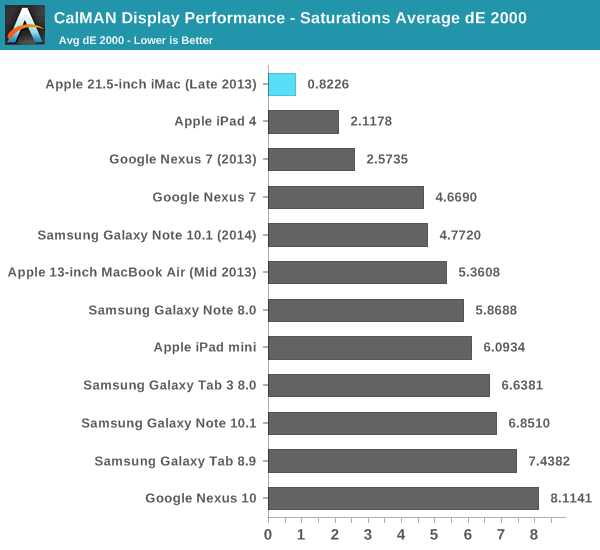
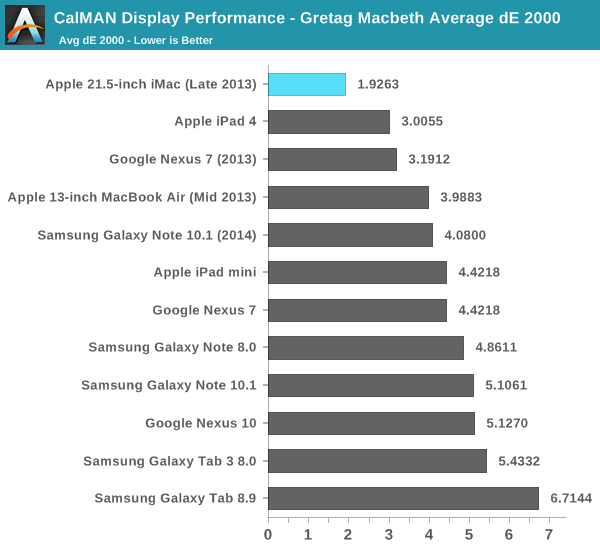

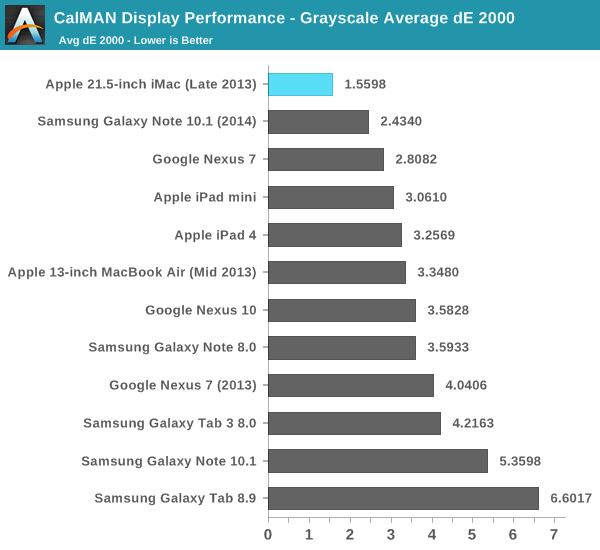
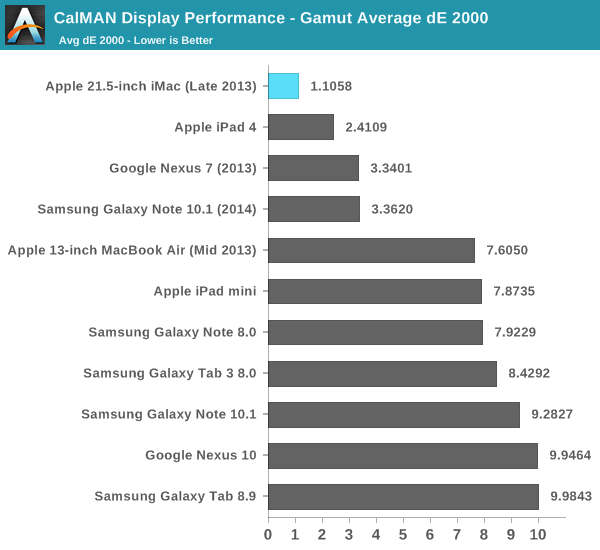

Although I doubt Apple’s intended audience for the entry-level 21.5-inch iMac are imaging professionals, they could very well use the system and be perfectly happy with it. Literally all that’s missing is a 2x resolution model, but my guess is it’ll be another year before we see that.
I have to point out that Apple does source its display panels from multiple providers (typically 2 or 3), not to mention panel variance within a lot. I don’t anticipate finding many panels better than the one in my review sample, but it’s always possible that there will be worse examples in the market. I haven’t seen huge variance in color accuracy from Apple panels, so I think it’s a pretty safe bet that what you’re going to get with any new iMac is going to be awesome.



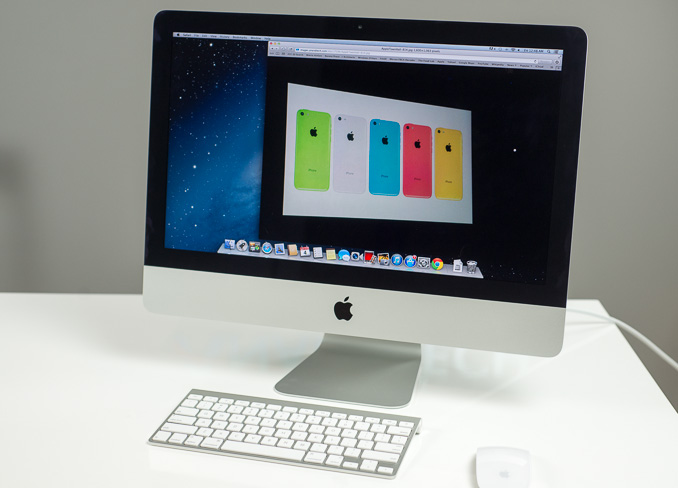











127 Comments
View All Comments
A5 - Monday, October 7, 2013 - link
Not really, no. They're at about the same level of abstraction since they both sit above the driver stack.Flunk - Monday, October 7, 2013 - link
There is also the issue that the driver sits farther up the stack than it does in Windows. Mach being a hybrid microkernel and all. I'm sure they can close the gap with a lot of work, but it doesn't erase the fact that Mac OS's basic structure is not designed to provide direct hardware access.overzealot - Monday, October 7, 2013 - link
The Windows kernel is also a hybrid microkernel.bestham - Monday, October 7, 2013 - link
"Storage & Fusion Drive – By default all of the iMacs come with a 3.5” mechanical hard drive." The physical harddrive size is differentiated between the 21.5" and the 27". I suspect that you already knew this but it slipped.Anand Lal Shimpi - Monday, October 7, 2013 - link
Thank you, fixed :)rootheday3 - Monday, October 7, 2013 - link
My opinion: Many games look pretty good at medium and it is not clear that the compromise in frame rate is worth it to push for higher settings vs running at medium with higher resolution.Regarding the Iris Pro gaming results - the jump from 13x7 medium (where Iris seems to have plenty of power to spare) up to 16x9 high/very high - this is a change of two variables: both resolution and settings.
Can you rerun some of the gaming tests at 16x9 medium (or maybe native panel resolution - 19x10 medium where 13x7 results were close to 60fps) to see what that shows?
rootheday3 - Monday, October 7, 2013 - link
one other question - is there any ability to OC the IGP in the bios? Typically Intel gpus have a fair bit of OC headroom and it would be interesting to see:1) what kind of performance/playability can be extracted
2) to what extent the igp clock frequency is the limiter on Iris Pro vs cpu, memory bandwidth, etc.
jeffkibuule - Monday, October 7, 2013 - link
This is a Mac! There is no bios, never has been.DanNeely - Monday, October 7, 2013 - link
Everyone who isn't an annoying pedant conflates bios and uefi in general usage.repoman27 - Monday, October 7, 2013 - link
And everyone who isn't an annoying pedant would also realize that jeffkibuule meant, "There is no [user accessible BIOS/EFI/UEFI], never has been."